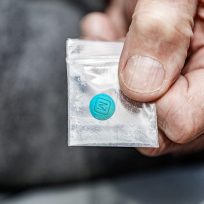Patients with a narcotic dependence may be physically dependent on opiates, heroin, painkillers, and other legal and illegal substances. An addiction can develop as quickly as two weeks after the first use and require a detoxification process that can be difficult to endure.
Traditional Methods of Drug Detoxification
Traditionally, patients with drug addictions may undergo abrupt withdrawal or opioid replacement to treat their narcotic dependence.
Abrupt withdrawal, also called quitting cold turkey, is excruciatingly painful and can be a dangerous method of detoxification. This method requires eliminating opiates from the body without any medical care. It is risky and often ineffective.
Opioid replacement is another traditional approach with a prolonged detoxification process and a high rate of relapse. Patients undergoing opioid replacement gradually reduce drug intake with the help of pharmacological agents that ease the symptoms of withdrawal. The drawbacks to this approach include the length of detoxification and the need to use other opiates that could lead to a new addiction.

Rapid Opiate Detox Under Anesthesia
Ultra rapid opiate detoxification (UROD) is a highly effective method that has grown in popularity around the world. With a low relapse rate it stands out among other detoxification practices.
UROD incorporates the best of the traditional detox methods: the quick aspect of the abrupt withdrawal method and the relative painlessness of the opioid replacement method. UROD has been formulated to speed up the detox process while restraining withdrawal symptoms to minimize discomfort.
Patients are placed under general anesthesia and given an opiate antagonist to cleanse the opioid receptors. The opioid antagonist used in opioid dependence management inhibits the competitive receptors to successfully block the effects of opioids. Opioid antagonists cannot lead to an addiction since they have no opioid agonist effect. Most withdrawal symptoms occur while a patient is under anesthesia, helping to reduce distress or pain that could potentially derail the procedure. Physical withdrawal from the opiates is mostly over once the patient recovers from the anesthesia.
A detoxification process that doesn’t incorporate medical help can cause severe body pain, insomnia, nausea, sweating, diarrhea, muscle twitches, and many other distressing symptoms. A patient’s body can experience elevated blood pressure, temperature, and respiratory rate, making detoxification unbearable. For this reason, many patients with a narcotic dependence struggle to break their addiction.

Rapid opiate detox under anesthesia allows patients to easily withstand the worst withdrawal symptoms in an unconscious state.
Rapid vs. Ultra Rapid Opiate Detoxification (UROD)
Unlike rapid detoxification, UROD only requires one procedure and is best suited for moderately addicted patients who only need to cleanse their opioid receptors. Lasting six to eight hours, the procedure eliminates all symptoms by the time the patient wakes up. Only one more day after detox is necessary for the patient to regain physical strength and regain full consciousness after anesthesia. Rapid opiate detoxification requires two or even three detox procedures, lasting four to six days. This approach is best for seriously addicted patients for whom a single detox procedure isn’t enough to complete the cleansing.







